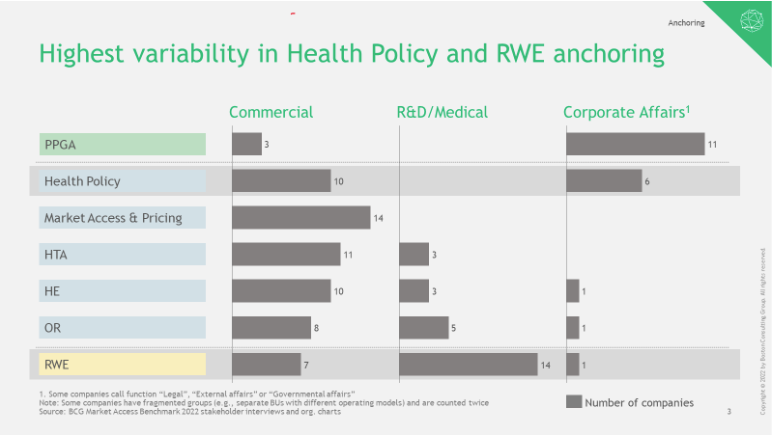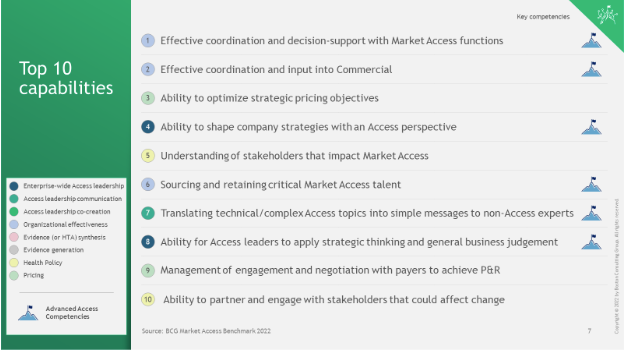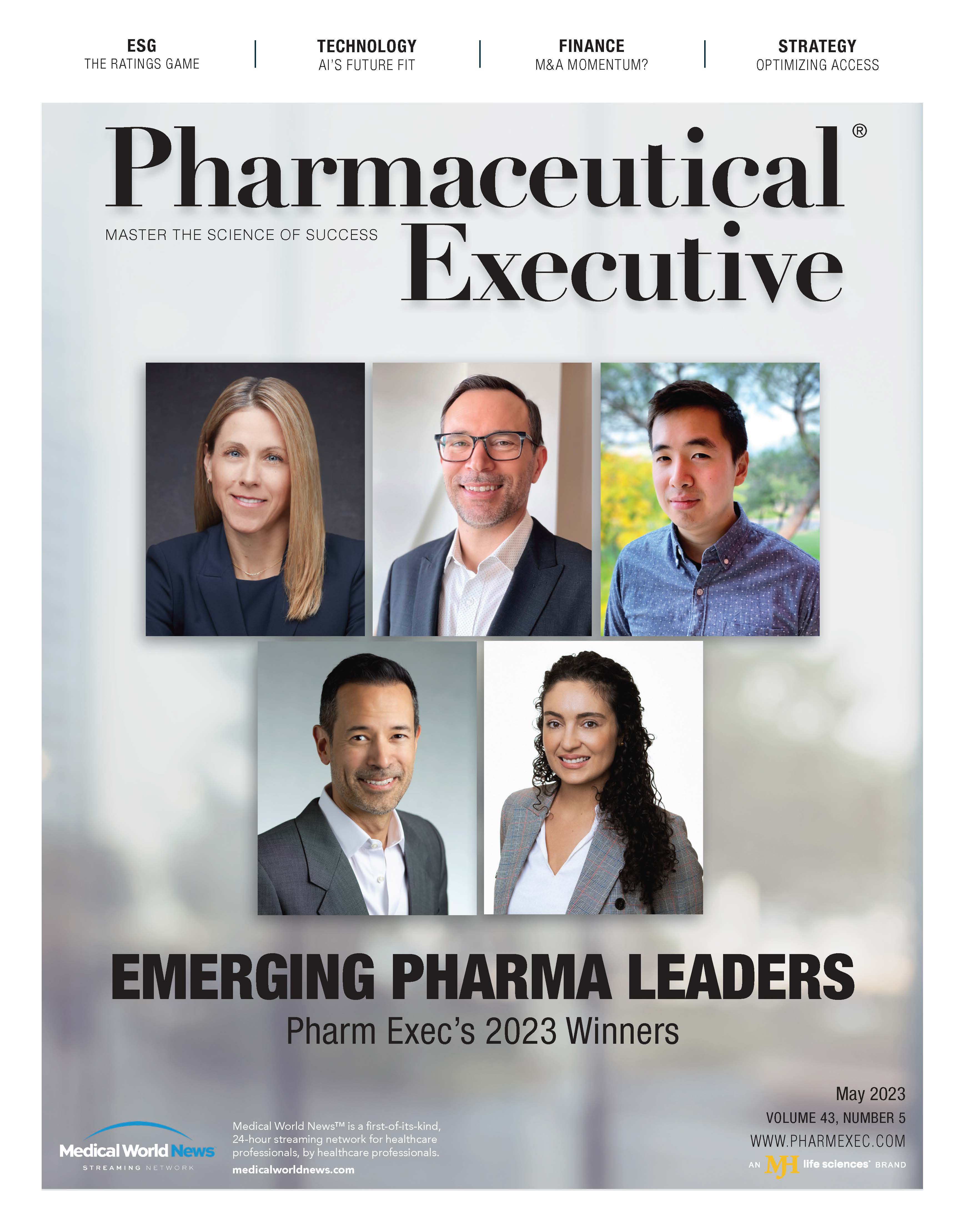A New Era for Market Access: Organizing the Function’s Broader Strategic Role
BCG’s 2022 benchmark study uncovers new competencies needed for pharma access leaders in enterprise-wide business strategy, where thoughtfully designed approaches and goals focused on shared priority and responsibility are increasingly important.
Over the past decade, market access (MA) evolved from a technical area required for product launch to a business-critical objective on the agenda of senior management. Along with the increased importance comes a greater need to collaborate and coordinate with other functions internally and with a larger set of stakeholders externally. Consequently, we see biopharmaceutical companies rethinking the setup of MA activities to deliver on their access priorities as a collaborative and cross-functional effort.
Since 2013, the Boston Consulting Group (BCG) Market Access Roundtable has been conducting a comprehensive benchmark of MA-related activities every three years. In this article, we highlight key observations from the 2022 benchmark, which include the priority topics that keep access leaders up at night; choices in organizational anchoring of MA activities; resourcing trends; the application of digital tools and data and analytics (D&A) in MA; and the new key competencies required to be successful in MA going forward.
Convening power
The BCG Market Access Roundtable is a forum that brings together senior MA leaders and serves as a platform for an interactive discussion on industry-level topics. Roundtable members collectively select topics that are relevant but not handled in other forums and that can have either near- or long-term relevance. Members work in smaller working groups on specific topics to develop thought pieces, relevant frameworks, or policy-related publications, which are collectively ratified by the roundtable on a biannual basis. BCG hosts this roundtable and facilitates these forums and the working groups. As of October 2022, 28 companies are full-time members of the BCG Market Access Roundtable.
Benchmark scope
The 2022 BCG Market Access Roundtable covers the “traditional” MA activities (e.g., pricing, health economics [HE], outcomes research [OR]) as well as activities that interface with other functions, namely health policy and real-world evidence (RWE). The benchmark is based on qualitative and quantitative data from 14 pharma companies and 150-plus interviews conducted with MA, health policy, and evidence-generation leaders from across global, regional, and nine local markets: US, EU4+1, China, Brazil, and Japan. In addition, we ran two structured surveys with more than 40 questions each and synthesized the responses of about 500 participants.
Market Access Priorities
In consolidating insights from our interviews with leaders in MA, health policy, and evidence generation, it has become evident that “governance and operational effectiveness” is the top common priority.
As the role of MA evolves into an orchestrator that ensures timely, equitable, and sustainable patient access, a shift is required from purely functional goals to shared objectives across functions. Also, it requires senior leaders to think differently about operationalizing the broader role of access, as outlined in our recent publication.1
Aside from the need to improve collaboration across the following three roles from a process and leadership competencies perspective, additional priorities that intersect between two functions were also highlighted:
1. For access and policy leaders:
- Pricing and affordability. The ability to achieve value-based prices across Europe and offer differentiated strategies to increase access for patients in low- and middle-income countries.
- Environment shaping.This is due to recent focus policy developments in the US (Inflation Reduction Act), China (commercial health insurance), and Europe (cost-containment measures following COVID-19).
2. For access and evidence generation/synthesis leaders:
- Integrated evidence strategy. Harnessing the potential of various sources of evidence and study designs to achieve fast approval and access.
- Launch readiness. Ensuring fast access and effective price negotiations both at national and regional levels.
3. For evidence generation/synthesis and policy leaders:
- HTA regulation. Specifically, the new European health technology assessment (HTA) regulation carries methodological and procedural implications for joint clinical assessment as well as country-specific adjustments on processes and guidance.
Figure 1.The highest variability in anchoring of market access activities are in health policy and real-world evidence.
Source: BCG Market Access Benchmark 2022 stakeholder interviews and organizational charts

ORGANIZATIONAL ANCHORING
In our benchmark analysis, we focus on seven key MA activities. Five of these are typically within the core of MA functions: pricing, HTA, HE, OR, and health policy. Additionally, we examine two closely related activities: public policy and government affairs (PPGA) and RWE (see Figure 1).
Upon examining and comparing how the seven key MA activities are anchored across the different companies, we identified five key trends that are worth noting:
- For traditional MA activities, pricing, HTA, HE, and OR are primarily anchored in commercial, while public PPGA primarily falls under corporate affairs.
- Half of the benchmark companies have dedicated health policy teams performing traditional MA activities, which is distinct from public policy.
- Most companies lack dedicated HTA strategy teams, with HTA responsibilities embedded directly within HE , OR, or access.
- For RWE, although traditionally anchored in R&D/medical in most companies, there has been an ongoing trend since 2019 to divide responsibility, allocating capacity/capability in commercial as well.
- While most global MA heads are positioned at the CEO-2 level, some have been appointed as chief access officers, reporting directly to the company CEO, which signifies the expanded role and importance of MA in commercial decision-making.
Organizational setup
There appears to be no dominant organizational design for traditional MA activities (e.g., pricing, HE, and OR) or activities that intersect with other functions—namely health policy and RWE. However, we found it useful to examine two dimensions that represent trade-off decisions companies have made:
- Degree of centralization vs. decentralization. There is a variation of approximately 1.25 times in the level of decentralization between individual companies. Hence, if centralized resources account for 15% of the total number of full-time equivalents (FTEs) in the least centralized company, the same resources will represent 40% of the total count in the most centralized. This variation is mainly driven by the overall context of the company—factors such as portfolio mix, commercial structures, strategic focus, etc. However, we can observe two general trends: a) an overall tendency to reduce regional resourcing in favor of “glocal” setups and b) increasing resources allocated in the US.
- Setup as an integrated function vs. anchoring by therapeutic areas (TAs). There is an even higher variation along this dimension, driven by distinct choices made by each company to address their specific current challenges (e.g., internal portfolio evolution, external TAs, product-specific policy changes, etc.). Interviewed leaders also emphasized the general expectation of further changes to come as internal strategic focus and portfolio/TA mix continue to evolve in tandem with external legal, regulatory, and HTA environments. Additionally, we discovered that while there is a wide spread in how functional resources are deployed (~1.33x above and below the average), a slight overall shift in the functional focus occurred with increased resources in customer-facing activities, particularly those that are local, such as access-related government or public affairs activities. There was also improved efficiency in technical evidence activities like HE/HTA modeling.
RESOURCING
In the 2013 benchmark, MA experienced a significant uptrend. Then in 2016, growth persisted, but MA resources began to stabilize. Fast forward to 2019, we saw an increase in shifts and optimizations, allowing teams to be more agile and access leaders to easily move resources between assets or geographies. Many companies continued to increase their resources on a global scale and within key European affiliates, while regions were consolidating their resources in about one-third of benchmarked companies. In the US, resourcing levels remained consistent.
In 2022, we observed a trend of resource growth in half of the peer companies for global, US, and key European affiliates. On the other hand, change in resourcing at the regional level was equally distributed between growth, decrease, and stable FTE levels.
As in previous years, we also examined the factors driving the overall resourcing of MA functions across the global, regional, and local deployment. We identified two distinct drivers at play:
- The launch needs are expressed by the number of mid- to late-stage products a company currently has in its pipeline. As MA activity tends to be most pronounced in the lead-up to and during launch, the number of mid- to late-stage products in the pipeline serves as a strong indicator of the MA resource requirements.
- The overall company size is expressed by the sales of its current products. The value generated from currently marketed products enables companies to hire MA resources. Larger organizations, due to sales, can afford to staff more extensive teams.
Scaling by launch needs and sales also helps control for the differences in TA focus, portfolio, size, and other factors. The close alignment to the regression, not only in 2022 but over time, underscores the validity of the two scaling factors.
Digital tools and D&A
Through our continued discussions at the BCG Market Access Roundtable, the role and usage of digital tools as well as D&A have emerged as a key joint topic to be assessed within core access, policy, and evidence- generation functions and across the product lifecycle.
First, we observed a common agreement between interviewed companies regarding the definitions of digital tools and D&A in the context of access:
- “Digital” is defined as the utilization of virtual channels and tools to support MA activities, such as organizing a virtual payer advisory board.
- “D&A” was defined as the use of systematic data analysis to identify meaningful patterns that support effective MA decision-making, such as using predictive analytics to inform HE and OR modeling.
We subsequently examined the top 10 current use cases in both digital tools and D&A and identified two emerging themes:
- Access teams demonstrate greater familiarity with the use of digital tools compared to D&A, which, although growing, remains in the initial stages of experimentation.
- While the most frequently used digital tools relate to market intelligence and stakeholder engagement, the usage of D&A primarily focuses on time-to-access and pricing considerations.
Finally, while digital competencies are mostly sourced externally, peers are still working through the best model to build or buy D&A capabilities.
ENSURING FUTURE SUCCESS
More than 400 MA colleagues from global, regional, and the nine largest countries identified what they perceive to be the key capabilities for future success (see Figure 2 on facing page). Ten capabilities emerged, considering traditional aspects of MA, such as health policy, evidence generation and synthesis, and pricing. Additionally, broader themes, such as organizational effectiveness and access leadership competencies, were highlighted.
Examining the top 10 capabilities, two advanced themes emerge as crucial: 1) access leadership competencies and 2) organizational effectiveness.
More than half of the top-ranked capabilities involve collaborating and co-creating with both internal and external stakeholders. As MA increasingly becomes a cross-functional endeavor, more MA objectives can only be achieved through support and collaboration from other functions. As a result, companies are optimizing their operating models to enhance collaboration across different TAs and/or functions. This has implications for how collaborations are organized across functions (operating model) and for the competencies access leaders need to effectively orchestrate this collaboration.
Therefore, the ability to steer the whole organization toward achieving MA goals becomes more complex. For access leaders, the ability to shape company strategies with an access perspective, to apply strategic thinking in their decision-making, and to translate complex/technical topics into simple messages are critical competencies for future success.
Figure 2. The key capabilities identified for future success in market access.
Source: BCG Market Access Benchmark 2022

OUTLOOK
In a world still recovering from the COVID-19 crisis, healthcare systems now need to address and mitigate the impact of inflation and the threat of global recession. Ultimately, this will result in more trade-offs for healthcare systems and payers to manage further constrained resources.
In this context, developing and implementing a thoughtful access strategy has taken center stage for pharma companies. Achieving access goals is increasingly considered a shared priority and responsibility. This perspective, on one hand, affords access leaders with greater visibility and importance; while, on the other, requires thoughtful collaboration and co-creation with other functions and leaders.
With an increased need for collaboration comes a need for greater competencies of access leaders in enterprise-wide business strategy, (access) communication, and leadership without authority. Furthermore, MA functions and teams must be structured to facilitate collaboration and co-creation, both within and outside the realm of MA. As a result, optimizing the operating model and governance for interactions across functions and between global, regional, and affiliates has become a strategic consideration across the board.
Authors
Michel Hochstrasser, managing director and partner; Jens Grueger, partner and director; Miguel de Gorgolas, senior knowledge analyst; Srikant Vaidyanathan, managing director and senior partner; all with Boston Consulting Group (BCG), and members of the BCG Market Access Roundtable
Reference
- BCG. A Cross-Functional Formula: Operationalizing the Broader Role of Access. Pharmaceutical Executive. 2022, 42 (8), 32-27. https://www.pharmexec.com/view/a-cross-functional-formula-operationalizing-the-broader-role-of-access

Trump: 'Major Tariff' on Pharmaceuticals Coming Soon
Published: April 9th 2025 | Updated: April 9th 2025“We’re going to tariff our pharmaceuticals, and once we do that, they are going to come rushing back into our country," President Donald J. Trump said during a Tuesday night dinner in Washington.